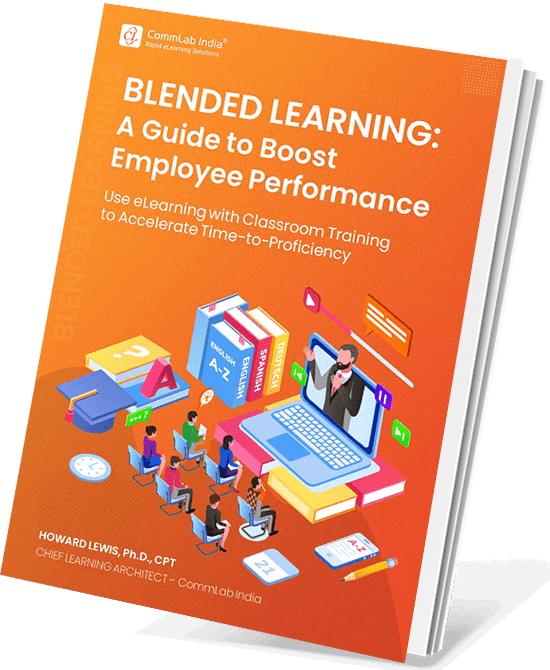Transform Leadership Training: Understanding Implications of Servant Leadership

In a world increasingly driven by bottom lines and short-term gains, a different leadership paradigm is emerging. Servant leadership is a leadership approach that is centered on serving others rather than seeking personal power. It is gaining traction as a more effective and sustainable approach to leading the modern-day workforce. In this blog, we’ll take a closer look at the practical implications of servant leadership along with a thorough understanding of
→ Download Now: Aligning L&D and Business: Ready to Conquer Future of Work?
Table of Contents
- What Is Servant Leadership?
- What Are the Practical Implications of Servant Leadership?
- What Are the Important Steps Toward Servant Leadership?
- How to Leverage Digital Learning for Leadership Training?
- How to Use Digital Learning in Leadership Training?
- How Major Industries Can Utilize Digital Learning for Leadership Training?
- Why Consider Blended Learning for Leadership Training?
- What Are the Benefits of Combining Blended Learning Techniques with Leadership Training?
- How to Implement Blended Learning for Leadership Training?
What Is Servant Leadership?
Need An Overview of Servant Leadership?
Here it is:
Servant leadership is a leadership philosophy where the leader's primary focus is on serving the needs of others, rather than seeking personal power or glory. The core idea is to put the well-being of employees, customers, and the community first.
Key Characteristics of a Servant Leader
- Empathy: Understanding and sharing the feelings of others.
- Listening: Actively seeking out the perspectives of others.
- Stewardship: Managing resources for the greater good.
- Commitment to the growth of people: Developing the potential of others.
- Building community: Fostering a sense of belonging and connection.
A servant leader is neither a servant nor a conventional leader but a rare and unique breed of leaders of the highest order. Most occupy the pinnacle of leadership and organizational success.
The main points of servant leadership are:
- Servant leadership is about human relationships of synergy rather than control.
- The servant leader spends his time promoting innovation, empowering others, and making sure that people are healthy, happy, and engaged.
- The long-term goal of servant leadership is to make similar leaders among employees.
- It exhibits a humane management style and demonstrates empathy, listening, stewardship, and commitment to the personal growth of others.
- Leaders are respected and have earned power rather than positional authority.
- The foundation of servant-leadership is trust, initiated by the leader, which is then reciprocated.
That said, there are certain limitations of servant leadership. Here’s a look.

What Are the Practical Implications of Servant Leadership?
Now that you’ve got a fair idea about what servant leadership is, this section will examine the feasibility of adopting this leadership style in corporate organizations, its relevance, opportunities, hurdles, and limitations.
Robert Greenleaf was quite clear and almost vehement in his observation that the servant leader starts as a servant because it is his or her innate nature to serve. And when the opportunity presents itself, he or she by deliberate choice, dons the cap of a leader, and not the other way around. So, according to Greenleaf, a leader cannot turn around and start serving people and thereby become a servant leader.
If we go by his reasoning, people occupying leadership positions in organizations are automatically disqualified because none of those leaders rose to the positions of leadership having started as servants. Greenleaf argues that people occupying leadership positions do so because of their need for power and/ or material benefits the position provides. In such a scenario, organizations need to wait for lower-level, non-managerial staff to evolve into servant leaders. I personally cannot think of any such instance where, say, a janitor evolves and occupies a servant leadership role. This is the first practical logjam that I have seen.

How L&D And Business Can Align to Conquer The Future Of Work
Bridging the Gap Between Organizational and Individual Goals!
- Learning Strategies Shaping the Future
- Changing Role of Learning Professionals
- Learning to Solve Business Challenges
- And More!
Other Logjams
- In a free market, companies compete against each other for a piece of the customer pie. This environment requires competitive and sometimes aggressive people to lead the company.
- In publicly funded companies, the leadership is accountable for the financial results and stock performance on an annual basis.
- Conventional leaders are people who take on enormous responsibility and expose their careers to risk and failure. They are mostly motivated by conventional needs like recognition, influence, and material benefits.
- Most leaders in large companies are employees, drawing a monthly paycheck, even if performance bonuses and stock options are considered to mean something. They are not the ultimate owners of the company.
- The primary owners are thousands of nameless shareholders and a few institutional investors, both of whom want their investment to yield maximum returns in minimum time.
To me, it looks like servant leadership cannot exist in its true essence in large, publicly funded organizations. It may be possible in smaller, family-owned, or partnership companies where the owners take an active part in running the business.
What Are the Important Steps Toward Servant Leadership?

There is some literature on the subject that promotes the idea that servant leadership can be a cyclic journey – one can start as a servant or as a leader and add the missing part. If we wish to accept this idea as a way out, there may be some small ways of implementing the spirit of servant leadership in business organizations. Although it looks to be an impossible task to bring about servant-leadership in totality, we can at least implement some small steps.
1. Treating People as People
To start with, stop referring to your people as ‘human resources’ or ‘resources’. Start calling them associates or partners or members or any other label that doesn’t demean them into the inanimate. While you are at it, rename your HR department appropriately.
2. Transparency
Share financial information about the company’s performance. If not the confidential sensitive information that may hurt the company if it falls into the wrong hands, at least the information that can be shared which will engender ownership and trust.
3. No Pecking Order
Remove all visible and invisible trappings of power and positional authority. Get rid of cabins and cubicles for “senior” leaders.
4. Food is Good
Invest in a good kitchen and cafeteria. Recruit professional cooks on the company rolls. The family that eats together stays together. Do not outsource to a catering agency.
5. Office Timings
Instead of checking when employees are logging in, check when they are logging out. Make it a strict policy to restrict work time to 8 hours. Reward people who honor this and penalize those who don’t.
6. Privacy
Never infringe on their weekly holidays and PTOs. Don’t call, message, or email them. In a hybrid or WFH model, don’t monitor screen activity or insist on the employees’ availability all the time. Measure them on deliverables and performance. Resist the temptation to put them on an electronic leash.
7. Roles and Responsibilities
It may be a good idea to make more experienced managers primarily mentors and leave the heavy lifting, including decision-making, to the younger generations.
8. Old and Young Blood
Youth crave career guidance and patience hearing from more experienced parent figures. They usually don’t get it from parents or older siblings. This is an acute need that can be addressed by most senior members, who in the process build future leaders and mentors.
9. The Old Should Blend
How many of us from Gen-X or Y even understand Gen-Z? We hardly know them, their language, their priorities, their avocations. We need to reduce our mental age and shift from our parent-egos state to our child and adult ego states.

How L&D And Business Can Align to Conquer The Future Of Work
Bridging the Gap Between Organizational and Individual Goals!
- Learning Strategies Shaping the Future
- Changing Role of Learning Professionals
- Learning to Solve Business Challenges
- And More!
How to Leverage Digital Learning for Leadership Training?
In today’s dynamic and competitive business landscape, effective leadership is paramount for organizations to thrive. Investing in leadership training is crucial to develop capable leaders who can navigate challenges, inspire teams, and drive success. With the advent of digital learning, organizations now have a transformative strategy at their disposal to enhance leadership development.

Digital learning enhances leadership training in several ways.
- It provides a diverse range of multimedia content, including videos, interactive modules, and simulations, which engage learners and cater to different learning styles.
- It allows for self-paced learning, enabling leaders to focus on areas where they need the most development.
- It facilitates collaboration and networking among leaders from diverse backgrounds, fostering knowledge sharing and peer learning.
A successful online learning platform for developing impactful, engaging leadership training courses should possess certain key components.

In addition to the abovementioned elements, features such as gamification, adaptive learning algorithms, and virtual mentorship can further enhance the effectiveness of the platform.
How to Use Digital Learning in Leadership Training?
1. Onboarding New Leaders
When a new leader joins an organization, digital learning can provide an efficient way to onboard them and equip them with the necessary leadership skills. Online modules, videos, and interactive simulations can introduce them to the organization’s values, culture, and leadership expectations. They can learn at their own pace, allowing them to quickly adapt to their new role.
2. Virtual Leadership Training Programs
Online leadership training platforms can host comprehensive leadership development programs. Participants can access online courses, webinars, and virtual workshops that cover a range of leadership competencies. These programs can include modules on communication skills, strategic thinking, decision-making, team building, and more. Learners can interact with instructors and fellow participants through discussion forums and virtual collaboration tools.
3. Gamified Leadership Simulations
Gamification can enhance leadership training by offering engaging and immersive scenarios with built-in game elements such as points, ranks, badges, leaderboards, mystery boxes, progress bars, levels, milestones, etc.
Simulations can present leaders with realistic challenges, allowing them to make decisions and witness the consequences of their actions in a risk-free environment. For example, leaders in the healthcare industry can experience decision-making during a crisis, while those in retail can practice managing a customer service team.

4. Adaptive Learning Paths
Digital learning platforms can utilize adaptive algorithms to personalize leadership training based on individuals’ skills, experience, and learning preferences. Through pre-assessments, the platform can identify knowledge gaps and recommend specific learning modules to address those gaps. This personalized approach ensures that leaders receive targeted training, optimizing their learning experience and outcomes.
5. Virtual Mentoring and Coaching
Digital learning can facilitate virtual mentoring and coaching sessions between experienced leaders and emerging leaders. Video conferencing, online chat platforms, and collaboration tools enable regular interactions and feedback. Mentors can guide leaders through real-world challenges, share insights, and help them develop effective leadership strategies.
6. Microlearning for Continuous Development
Microlearning involves delivering short bursts of content focused on specific leadership skills or topics. Digital learning platforms can provide bite-sized videos, articles, podcasts, or infographics that leaders can access on demand. This approach allows busy leaders to engage in continuous learning, fitting it into their schedules whenever they have a few minutes to spare.

7. Performance Tracking and Analytics
Digital learning platforms offer robust tracking and analytics capabilities, enabling organizations to monitor leaders’ progress, learner engagement, and performance. Through learning analytics, trainers can assess leaders’ knowledge retention, skill development, and the impact of training on their job performance. This data helps organizations identify areas for improvement, refine training programs, and measure the return on investment (ROI) of leadership training initiatives.
How Major Industries Can Utilize Digital Learning for Leadership Training?
1. Healthcare Industry
The healthcare industry can leverage digital learning to develop effective leaders who can navigate complex regulatory environments, manage teams during crises, and drive patient-centric care. Digital platforms can offer specialized modules on healthcare leadership, addressing topics such as ethical decision-making, patient safety, and organizational resilience.
By leveraging digital learning for leadership training, the healthcare industry can equip leaders with the necessary skills to make informed decisions, lead multidisciplinary teams, and foster a culture of continuous improvement, ultimately enhancing patient outcomes and driving positive change in the industry.
2. Retail Industry
Digital learning can equip retail leaders with the skills to excel in customer service, team management, and adaptability. Digital learning platforms provide tailored training modules that address the unique challenges faced by retail leaders. These modules can focus on building customer-centric leadership, leveraging data analytics for decision-making, and developing agile retail strategies to thrive in a rapidly changing market.
By leveraging digital learning, the retail industry can empower leaders to:
- Enhance customer experiences
- Drive sales performance
- Stay ahead in a rapidly evolving market landscape

3. IT Industry
In the technology sector, leadership skills need to align with innovation, collaboration, and strategic thinking. The rapidly evolving nature of technology demands leaders who can navigate complexities, drive innovation, and foster a culture of continuous learning.
Digital learning platforms play a crucial role in developing tech leaders by providing specialized content and training modules tailored to the industry’s unique challenges. Digital learning platforms can provide specialized content on leading cross-functional teams, fostering a culture of innovation, and navigating the challenges of digital transformation.
4. Finance Industry
Leaders in the finance industry require a unique set of skills to navigate the complexities of risk management, regulatory compliance, and strategic decision-making. Digital learning platforms offer targeted training modules to develop finance leaders who can excel in these areas. These modules may cover topics such as financial analysis, risk assessment and mitigation, regulatory frameworks, and strategic financial management. By leveraging digital learning in leadership training, the finance industry can equip leaders with the knowledge and expertise needed to make informed financial decisions, manage risks effectively, and drive sustainable growth in a highly regulated environment.
Leveraging digital learning for leadership training offers organizations a powerful method to develop capable leaders who can thrive in today’s dynamic business landscape.

How L&D And Business Can Align to Conquer The Future Of Work
Bridging the Gap Between Organizational and Individual Goals!
- Learning Strategies Shaping the Future
- Changing Role of Learning Professionals
- Learning to Solve Business Challenges
- And More!
Why Consider Blended Learning for Leadership Training?
From the time the COVID-19 pandemic began, L&D professionals have had to alter their approach to corporate leadership training. Face-to-face Instructor-led Training (ILT) sessions have transitioned into Virtual Instructor-led Training (VILT) sessions, and the trend is here to stay.
Conventional corporate training programs have their own share of shortcomings. For instance, when training is not customized according to the employee’s specific needs, preferences, and skill sets, it can be quite stagnant. And leadership training, which covers deeper and more complex topics – has to be well-designed.
This is where blended learning comes in. It enhances learning outcomes for senior management by combining online learning with traditional, instructor-led face-to-face sessions.
What Are the Benefits of Combining Blended Learning Techniques with Leadership Training?
Unlike technical skills, leadership is a skill that can’t be acquired by merely taking a course. Organizations need experienced coaches and mentors to train senior managers by providing real-world insights and shared experiences. Therefore, in-person Instructor-led Training sessions were always the go-to choice for leadership training.
Unfortunately, the logistic legwork has made it difficult to conduct in-person training sessions and blended learning has become a necessity overnight. This innovative training method can accommodate several engrossing formats including microlearning, Virtual Instructor-led Training (VILT), and gamification to mimic the experience of Instructor-led Training while at the same time improving learning outcomes.

Let’s check the key benefits of combining blended learning techniques with leadership training in detail.
1. Increased Learning Impact
On paper, blended learning can look like a mismatch between online and traditional training methods. However, if you look at it from a different angle, you’ll notice that these two approaches complement each other, and, due to their cost-effectiveness and flexibility, the blended learning model is becoming increasingly appealing to organizations and learners alike.
The interactive nature of the blended learning approach gives leaders the freedom to actively participate in sessions, improve their skills faster, and apply what they have learned to their everyday tasks. Additionally, many employees are becoming increasingly comfortable with online learning. Thus, blended learning offers them the opportunity to learn new skills and investigate new concepts from the safety of their comfort zones.
2. Personalized Learning
Every leader is different. You cannot teach a fish to climb a tree or a lion to breathe underwater. In other words, you cannot try to upskill everyone using the same methods and approaches. Therefore, you need to let each employee determine their own way and pace of learning. The best benefit of blended learning is that it supports distinct types of learning styles. For instance, some individuals enjoy spending a long time on exercises and group projects online, while others prefer short instructional videos. And blended learning can support this!
Check out the video below to learn how you can create personalized learning experiences with the help of ChatGPT.
3. Enhanced Flexibility
Blended learning is perfect for modern employees with busy routines and tight schedules. It enables them to participate in training asynchronously. In other words, those who find it difficult to commit to in-person sessions can learn at their convenience by taking online training courses.
4. Improved Workplace Connections
While eLearning offers a host of benefits, it doesn’t necessarily facilitate a lot of interaction with co-workers or instructors. However, blended learning overcomes this obstacle naturally. Blended learning enhances leadership training programs, encourages teamwork, and helps leaders effectively connect with others through digital media.
5. Reduced Costs and Enhanced Scalability
By using a blended learning approach, L&D teams and managers significantly reduce leadership training costs in terms of travel, facilitator accommodation, training materials, booking venues, and instructor fees. Moreover, blended learning programs are scalable, which means their content can be upgraded over time based on emerging trends, skills, and organizational needs.
6. Enhanced Learning Outcomes Due to Multiple Modalities
Many studies suggest that most people learn better when they participate in multiple modes of learning such as VILT sessions, microlearning videos, and quizzes, just to name a few. Moreover, blended learning adds the human element by employing techniques such as video conferencing, discussion forums, and social media platforms that work together to improve knowledge retention and application.
How to Implement Blended Learning for Leadership Training?
Watch the video below to explore different blended learning formats and how you can use them to enhance your leadership training.
Parting Thoughts!
In these times of WFH, hybrid models, the gig economy, and the entrepreneurial spirit that is raging the world over, it is time for leaders across industries to rethink how they are going to ‘manage’ their people. This generation and the future ones no longer want to be managed. They do not work for a livelihood or to better their standard of living. Their parents have taken care of those for them. They are better educated, widely traveled, and more technologically and financially savvy than their parents ever were. They want their jobs to offer them challenges, learning, freedom, responsibility, and risks, yes, the risk of failure in their work. More so, they loathe control, and regimentation of any kind nor do they want to hear the wise man’s tales. They prefer collaboration to competition. Most of them are excellent autodidacts.
These are the people that will form most of the workforce in the next decade. It is time to think if we can continue to deal with them the same way we have for the last 50 years. I certainly don’t think so. Maybe servant leadership has now come of age. We cannot even think out of the box. There is no box!
Editor’s note: This post was originally published on October 12, 2022 and has been updated for comprehensiveness.





![Key Leadership Skills to Overcome Business Challenges [Infographic]](https://blog.commlabindia.com/hubfs/blogs/key-leadership-skills-overcome-business-challenges-info.jpg)